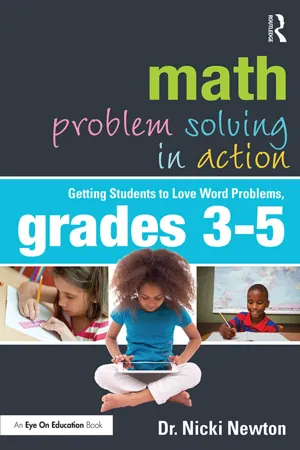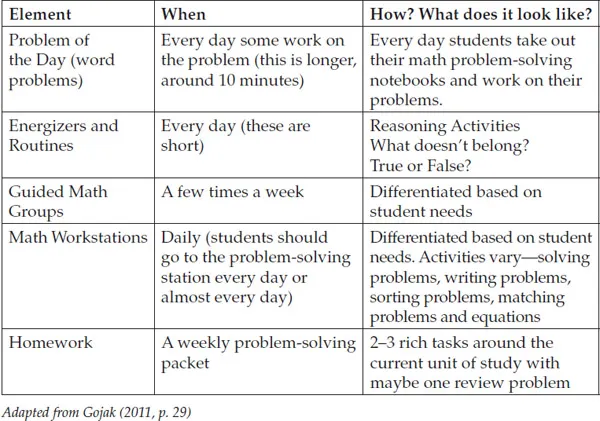![]()
1
Real Stories, Deep Understanding
We Don’t Grow Cornfields in the South Bronx
Researchers have found that story problems “are notoriously difficult to solve” (Cummins, Kintsh, Reusser & Weimer, 1988). Geary (1994) found that “children make more errors when solving word problems than when solving comparable number problems” (p. 96). Koedinger and Nathan (2004) note that Gary Larson’s cartoon captioned Hells Library has bookshelves full of titles like Story Problems, More Story Problems and Story Problems Galore and is a powerful commentary on how we feel as a society about story problems.
Students hate problem solving, but it should be presented as a challenge. Students should look forward to working with word problems because it’s the stuff they do every day. We simply have to mathematize the stuff they do every day. Students should own the problems they solve and pose. They should tell problems about their families, their friends, their daily activities, their school and their lives. If the problems made sense to the students, then students could make sense of the problems.
Often I hear people talk and write about real-life problems, and when I look at some of those problems, I think to myself, “Whose life is that?” When I am teaching in the South Bronx, a problem about rows of corn in a cornfield isn’t exactly a go-to example. However, if I talk about getting some candy from the corner bodega (small grocery store), then everybody is with me. Now, this is not to say that they won’t be able to solve the problem about the rows of corn in the Nebraska cornfield, but it is to say that the starting point isn’t Nebraska.
Real-Life Examples about Real-Life Problems
A few years ago, I was in the South Bronx working with a brand-new fifth-grade teacher. I walked into his classroom and he looked visibly relieved to see me coming through the door. He said, ’Hey, Dr. Nicki. We are working on dividing decimals.” He pointed to a problem about knitting on the board. He then looked at me like “Help.” I smiled and said, “Okay, I’m going to start with a different problem.”
I sat in the wooden chair, faced the students and asked them how many stopped at the corner bodega that morning (which is a common routine among the schoolchildren). I asked if they had $3.00, how many egg sandwiches could they buy. Everybody began calculating and they figured it out. Then I posed a different problem. I asked what if I had 75 cents, how many mini bags of potato chips could I buy? The children knew instantly how many bags of chips I could get, because they do that every day.
These are real-life problems, problems that the students live in their daily lives. That’s what students need—real-life problems. I gave them several problems about the bodega where they had to divide decimals, but I didn’t tell them what they were doing specifically, until we were deep into it. Then I said, “Hey, what we are doing is dividing decimals. There is a way to do this with numbers. Mr. Amancio1 is going to show you.”
We ended the period with an exit slip that asked the students how they felt about dividing decimals. Most everybody said it was easy. You know why. Because it was connected to their everyday lives. Mr. Amancio eventually got to that text-book problem, but only after the students actually understood the math.
This experience resonates with the National Research Council’s (NRC, 2001, p. 130) research that shows students can engage successfully in reasoning about problems when three conditions are met:
- Students have a knowledge base.
- Students understand the problem and are motivated by the content.
- The context is familiar and comfortable.
Problem Solving Throughout the Math Class
Problem solving should be done every day as a whole class routine (see Figure 1.1). It should also be done in small guided math groups and math workstations. When done in whole groups, the emphasis is on developing the habits of mind and ways of doing that good problem solvers need. The focus here is not on quickly solving a problem but on going through the process of problem solving. It is a practice that is developed over time. Great problem solving is interwoven throughout the math block (see Figure 1.1).
Perseverance
One of the most important things that students need to know about problem solving is that they have to persevere with the problems. They need to get the idea that they have to stick with it and can’t give up. There should be mini-lessons around perseverance. There are so many ways to teach and talk about this now with videos, picture books, songs and posters (see https://www.pinterest.com/drnicki7/growth-mindsetperseverance/). There are several great videos. The Michael Jordan/Nike commercial where he talks about being a winner because he has practiced and failed so many times is phenomenal. There are different versions of this commercial, but a really powerful one shows him messing up on the court with the following voice-over:
Figure 1.1 Problem Solving in Math Block
I’ve missed more than 9000 shots in my career. I’ve lost almost 300 games. Twenty-six times, I’ve been trusted to take the game winning shot and missed. I’ve failed over and over and over again in my life. And that is why I succeed!
(http://www.brainyquote.com/quotes/authors/m/michael_jordan.html)
What a powerful video! The discussion that pursues is the linchpin to the year. Students have to understand that problem solving is about sticking with it. There are some powerful posters like the powerful Japanese proverb: “Fall seven times, stand up eight.”
One third-grade teacher said that she had to persevere to teach her students what the poster meant. Being children, at first they took the saying literally. They said that it meant if you fall down seven times, just keep standing up. She eventually got them to see the metaphor! There is a video entitled Brain Jump with Ned the Neuron (https://www.pinterest.com/pin/142004194478586625) where the brain is talking to the students and teaching them that when they struggle to understand, they are actually exercising the brain and helping it to grow.
Whole Group Lessons: Rethinking Problem of the Day
A problem of the day is often an exercise in answer-getting. Students are given a problem, a bit of time to work through it and then the answer is discussed. I propose we do something radically different. That we don’t rush to the answer. That we do what Phil Daro says, “Delay answer-getting” (http://serpmedia.org/daro-talks/index.html). Sometimes, even give the students the answer so that part is done. Then, focus on the process of problem solving. Rather than a problem of the day, consider it more of like a problem of the week.
Students get the problem the first day, they read it, visualize it and discuss it with partners, in small groups and together with the whole class. The initial emphasis is to get everyone to understand the problem. In order to do this, they need to visualize and summarize the problem. That means they need to make a picture of the problem in their heads and then talk about what that picture looks like. As part of the whole class routine, students should share out their thinking and then discuss that thinking to see if everyone agrees what the problem is about. That might be all they do on day one.
The next thing the students should do is decide what type of problem it is and what they are looking for. Students should write a set-up equation with a question mark or letter for the unknown part. It is important that students can identify what they are looking for exactly and that they write a set-up equation. Students should use the letters of the things that they are working with. For example, if the problem is about marbles, then the students use an M to designate the unknown.
The next thing students should do is make a written plan rather than simply picking some numbers and jumping into the problem to find an answer. The practice of thinking about the problem and really deciding what it is about is powerful. Students should write what they are going to do and then do that. After they have solved using one way, they should always be encouraged to check another. This might take two or three days.
It is important for students to be able to make connections between different representations of the problem, such as equations, verbal descriptions, tables, graphs, sketches and diagrams (NCTM, 2000; CCSS, 2010). They should always read the work of others to see if it makes sense, and if it doesn’t, they should have the language to challenge each other or ask for clarification.
The next thing students should do is double-double-check their work. I have found that when teachers tell students to check their work, they tend to check the math. The math could be correct and the answer wrong. For example, 3 × 3 = 9, but it might have been a division problem. So, ask students to check the math and check to see if the answer makes sense.
In order to do all of this and to do it ...

